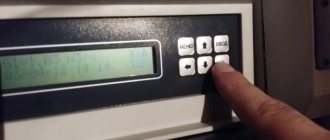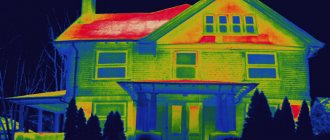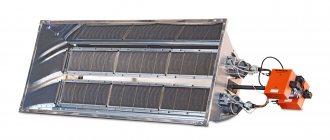Why do you need a heating meter?
Probably everyone has encountered problems with central heating batteries. Modern houses are designed with autonomous heating, so that the consumption is calculated for each apartment separately. People who live in older houses do not have such a prerogative. Sometimes they have to suffer because utility services want to save money and turn up the heating, as a result, the temperature in the house drops, and the bills come in sky high, the question arises: what are we paying for then?
Let's consider the main problems of centralized heating:
- The used cubic meters of heat are distributed to all apartments, taking into account data on the area of the apartment from those. passports, but redesigned, enlarged apartments are not taken into account. So you may end up paying more for luckier neighbors.
- Significantly less heat enters the batteries than comes out of the boiler room. In fact, the cost of heating includes heat that does not even enter your apartment.
- The plumbers turn up the heating, you freeze or use additional heating methods (for which you also pay), and the bills come the same.
Important! Considering the listed disadvantages of central heating, one can understand why so many people want to install individual meters. About 30% of the heat we pay for does not reach the apartment.
By installing the device in an apartment, we can check how much heat is supplied and pay only for it. If you don't have enough heating power, you will at least pay an adequate price.
The question of the cost of installing a common house heat meter and economic benefits
It should be noted that the issue of installing a common house heat meter sometimes causes obvious or hidden opposition from residents of the house. The reason for this is the rather high costs of purchasing a metering device and its installation, which must be borne by the apartment owners. And even the real return on costs within 2-3 years may not always be convincing. Although, if we take into account the fact that the installed heat unit is the legal boundary between the areas of responsibility of the resource supply organization and the residents (represented by the management company or HOA), then the issue of installing a heat meter looks very attractive. Indeed, in this case, all attempts by the resource supplying organization to prove that they supplied more heat to the house than the device recorded are doomed, since it is the meter readings that have priority.
The cost of installing or replacing a heat meter consists of several criteria:
- prices of the metering device, its configuration and functionality;
- development and approval of design and technical documentation;
- the need for additional construction or plumbing work;
- installation difficulties, etc.
It is important to pay attention to the fact that you need to choose reliable models of heat meters that will be the optimal type of device for operation in specific conditions. In addition, it should be remembered that periodically the metering device must undergo verification, as a result of which either a positive verdict is issued and the meter can continue to operate, or it is declared unfit for further use. In the latter case, the heat meter needs to be replaced.
ORDER A SERVICE FROM ACCREDITED COMPANIES
Is it possible to install a heat meter in an apartment?
The question: is it allowed to install heat meters in an apartment still remains relevant.
The World Wide Web gives diametrically opposed answers. Perhaps the utility services themselves are misleading people, since they do not really benefit from such modernization. However, we cannot be fooled so easily; after reviewing the legislation, we made an unambiguous conclusion: it is possible to establish, but there are several nuances.
Please note that installing a heat meter in an apartment yourself is not only prohibited, but also very dangerous. Outside interference in the heating system can result in an accident, and if everything goes smoothly, then, in any case, it will not be accepted by the heating service.
If you decide to install such a meter, then you need to do everything according to the rules.
When installation is not possible
There is no legislation prohibiting the installation of your own meter, but there are cases when technically installing it simply does not make sense. This situation is possible in very old houses, where changing the heating system is impossible or not profitable.
Basically, the problem lies in the wiring of the heating system. It comes in two types:
- Vertical system. Heat passes through all floors up and then back. In this case, there are usually several risers per apartment, and a meter will have to be installed on each of them, which is very expensive. Most often, such heating is installed in Khrushchev-era buildings.
- Horizontal - has two pipes, heat enters through one, and through the other it goes out with one riser to the apartment. Therefore, installing a meter will not be a problem.
To be absolutely sure whether a heat meter can be installed in an apartment, contact a specialist. They will conduct an inspection and tell you how effective the modernization will be and how much it will cost to maintain this system.
Heat meters in the legislation of the Russian Federation
It is important to note that in the Russian Federation there is a law that obliges the installation of heat meters in an apartment building at the expense of the residents. If this is not done, then you will have to pay a tariff with a coefficient of 1.5, if not more.
In this case, it does not matter whether you have an individual meter for your apartment; its readings will not be taken into account. Therefore, first make sure that your house has a common meter, and then install an individual one according to the procedure established by law.
Installation of metering units
Installation of a collective (common house) metering unit for thermal energy and coolant by consumers of State Unitary Enterprise "Sevteploenergo"
In accordance with the Federal Law of the Russian Federation of November 23, 2009. No. 261-FZ “On energy saving and increasing energy efficiency, and on introducing amendments to certain legislative acts of the Russian Federation”, owners of premises in apartment buildings are required to install thermal energy meters within the time limits specified in the current legislation.
We draw your attention to the fact that only those metering units that are equipped with heat meters and metering devices, the types of which are included in the Federal Information Fund for Ensuring the Uniformity of Measurements, are allowed for installation. You can view the list of equipment approved for use on the territory of the Russian Federation on the website of the Federal Information Fund for Ensuring the Uniformity of Measurements by clicking on the link https://fundmetrology.ru.
The list of equipment included in the metering unit is determined by Part 2 of the Rules for commercial metering of thermal energy and coolant approved by Decree of the Government of the Russian Federation of November 18, 2013 No. 1034.
You can find catalogs of manufactured products and a list of services provided (technical characteristics, cost of equipment included in the thermal energy metering unit, list and cost of services provided for design, installation, commissioning and maintenance of thermal energy metering units) on the Internet at the websites equipment manufacturers or any specialized organizations that have the right to conduct this type of activity. Below are links to the websites of manufacturers of equipment intended for thermal energy metering:
www.teplocom-sale.ru,
www.vzljot.ru,
www.termotronic.ru,
www.promservis.ru
www.karat-npo.com.
Please note that the data on manufacturers is for informational purposes only; the consumer of thermal energy has the right to use the services of any other supplier or service organization that meets the current requirements of the Legislation of the Russian Federation.
THIS IS IMPORTANT TO KNOW!!!
Please note that in accordance with the requirements of the Federal Law of the Russian Federation dated November 23, 2009. No. 261-FZ “On energy saving and increasing energy efficiency and on introducing amendments to certain legislative acts of the Russian Federation” heat supply facilities where, in violation of the requirements of Art. 13 Federal Law-261 dated November 23, 2009, until January 1, 2019 (until January 1, 2021 for consumers whose maximum volume of thermal energy consumption is less than two tenths of Gcal/h), a set of installation and commissioning works will not be completed into operation of thermal energy metering units are subject to be equipped with thermal energy metering devices at the expense of the efforts and resources of organizations supplying or transmitting thermal energy and whose engineering and technical support networks are directly connected to the networks that are part of the engineering and technical equipment of these objects ( heat supply organizations).
The costs of installing/replacing a heat metering device, in this case, incurred by the heat supply organization are subject to reimbursement by the owners (owners) of heat supply facilities at which the installation of thermal energy metering devices will be carried out within the framework of the agreement governing the terms of installation/replacement of thermal energy metering devices.
The current legislation of the Russian Federation allows for reimbursement of costs incurred by heat supply organizations for the installation of thermal energy metering units (for the population category) in equal shares within five years from the date of conclusion of the agreement governing the conditions for the installation/replacement of thermal energy metering devices. If an installment plan is included in an agreement for the installation/replacement of heat energy metering devices, the price of such an agreement must include the amount of interest accrued in connection with the provision of an installment plan, but not more than the refinancing rate of the Central Bank of the Russian Federation in effect on the day of accrual.
In the event that the owners (owners) of heat supply facilities refuse to pay on a voluntary basis the costs incurred by heat supply organizations for the installation/replacement of heat energy metering devices, the costs incurred by heat supply organizations associated with the need for compulsory collection are also subject to inclusion in the price.
Composition of the cost of the contract regulating the terms of installation/replacement of thermal energy metering devices:
- Pre-project inspection and development of design documentation for the installation of a thermal energy metering unit - the cost is determined by a specialized organization that has the right to conduct this type of activity. Depends on the heat supply facility.
- The composition of the set of equipment specified in the design documentation for the installation of a thermal energy metering unit - the cost is set by the manufacturers of thermal energy metering devices. Depends on the heat supply facility.
- Work on the installation of a thermal energy metering unit - the cost is determined by a specialized organization that has the right to conduct this type of activity. Depends on the heat supply facility.
- Commissioning work for commissioning a thermal energy metering unit - the cost is determined by a specialized organization that has the right to conduct this type of activity.
Estimated cost of the thermal energy metering unit and the complex of works associated with its installation:
The estimated cost of thermal energy metering units and their installation is: with a two-pipe system (for heating only) - about 200,000 rubles, with a four-pipe system (for heating and hot water supply) - about 400,000 rubles.
The indicated approximate cost includes the costs of developing project documentation, equipment for the metering unit, its acquisition, installation and commissioning, subject to a one-time payment. The final cost of installing a metering unit is determined individually after a preliminary examination and will depend on the design features of the internal engineering networks of each facility (number of inputs, complexity of installation, volume of associated consumables, need for anti-vandal protection, etc.)
Sample contract for installation of a metering device ()
The procedure for installing metering devices during self-installation:
- Owners of residential and non-residential premises in apartment buildings
- To other consumers
List of apartment buildings that need to be equipped with metering devices (document in development)
Request for the provision of technical specifications for the installation and technical equipment of newly constructed facilities
Request for provision of technical specifications for the technical specifications of existing facilities
The procedure for legal installation of a heat meter
The legislation does not prescribe mandatory standards for heating meters per apartment. But the law specifies the procedure that must be followed to install a heat meter:
- Write a statement to the organization that supplies heat to your home. Specialists will check the possibility of carrying out this procedure from a technical point of view. After checking, if everything is fine, then you will receive technical support. conditions that specify the nuances of developing and installing a meter in your apartment.
- If you have created a condominium association, then its chairman needs to provide a copy of the application and clarify the process of installing the heat meter.
- Find an organization that develops projects for installing heat meters, check that they have all the documents confirming their qualifications in this matter.
- Approve the project from the company that supplies heat, then contact the company that installs heat meters.
- The installed equipment must be shown to the heat supply company and an agreement must be signed with them. A specialist from this company will service the heat meter, but at your expense. From now on, you will pay for the actual heat you use.
For reference: the meter will count the heat consumption only for your apartment, but you will be required to pay part of the amount for heating the non-residential premises of the house, along with other residents.
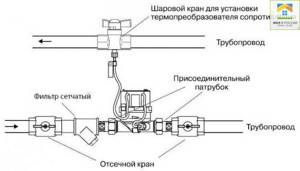
Types of heat meters for heating
If you have already decided to install a heating meter in your apartment and have checked all the technical capabilities of the house, then it’s time to think about which device to buy. Heat meters come in several types; they differ in price, quality, durability and temperature measurement method, but functionally they perform the same role.
Mechanical heat meters
Let's start with the simplest and most budget option - a mechanical heat meter. This option is the cheapest, but also the most short-lived. It does not tolerate dirt, temperature changes, or rust well, so in just a couple of years you will have to buy a new one. The design of a mechanical meter is very simple: a gear rotates inside and moves numbers that show how much heat your apartment consumes. The system is almost identical to the light meter.
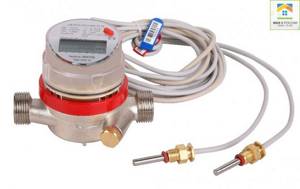
Ultrasonic meters
They more accurately measure the amount of heat received. Such a device will last a very long time if you install a special filter so that only water purified from debris passes through the meter. Its price is higher than that of a mechanical counter. Although if you calculate how much budget money you will save on purchasing and repairing a device, the issue is moot. Heat suppliers often insist on choosing just such a meter, because its measurements cannot be influenced from the outside.

Vortex heat meters
This type of heat meter calculates the wasted heat using obstacles that are created during water circulation (vortexes). This universal device is suitable for horizontal and vertical heating systems and shows accurate data despite various deposits in the pipes. When choosing a vortex heat meter, you need to take into account the size of the pipe to which the device will be attached.

Electromagnetic meters
When water moves through the pipes and delivers heat to our apartment, a certain amount of current is generated, which is read by the electromagnetic meter. Electromagnetic meters are cheaper, so they are very popular. This is a kind of improved version of a mechanical meter.
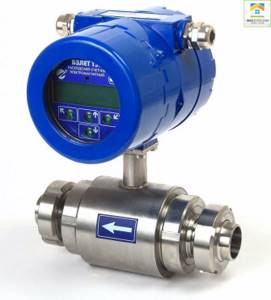
Poor quality water, as well as improper installation of the device, can lead to rapid breakdown of the device. This option is used both for the whole house and as an individual meter for an apartment.
General and individual heat meters
Depending on the purpose, the metering device is installed:
- on the inlet manifold for supplying coolant to a multi-storey residential building. This ensures that the heat received by all apartments is taken into account;
- on separate pipes that lead to a specific apartment.
The industry produces counters of different types. Each consumer chooses the one that, in his opinion, is the best.
It can be:
- mechanical;
- ultrasonic;
- vortex;
- electromagnetic.
If ultrasonic ones are used by individual consumers, then all others can be installed both in the entire house and in a separate apartment.
A common house metering device is installed on the supply main line running in the basement. After the meter, heat is supplied to the apartments.
Remember! The readings on the meter are displayed in gigacalories. On a certain date, usually the last days of the month, current readings are taken. Then the difference with previous readings is calculated.
The resulting number is multiplied by the tariff approved by the government agency. The result will be the amount that must be paid to the entire house. Then, depending on the area of the apartments, the amount is distributed to each payer.
Thus, apartment owners pay for heating:
- your apartment;
- landings;
- basements and attics;
- common areas.
Can I install the meter myself?
General accounting of thermal energy consumption, despite its positive features, has its drawbacks:
- to install a general metering device, you will need to obtain the consent of all residents of the house, which is not so simple;
- the general device does not take into account the uneven distribution of heat. Thus, insulated apartments and those located in the middle of the house will consume less heat, while those on the outermost and uninsulated ones will consume more. In this case, all owners will pay in proportion to the area of their apartments, regardless of the above factors;
- owners of apartments that are very warm would rather open the windows than screw in the radiators. After all, you won’t be able to save on heating with general metering.
The issue of reducing the cost of payment services can only be resolved by installing individual metering devices. They are mounted on each heating battery. The costs of their acquisition and maintenance are borne entirely by the homeowner.
However, he gets the opportunity to independently regulate the heating temperature of his apartment and calculate his financial capabilities for paying for heat.
However, service providers do not agree with this approach to heat metering. In addition, the old heating distribution system forces a meter to be installed on each riser leading to the battery. And this is a very expensive pleasure.
Even if you decide to do this, you will have to install them only in the warm season. Moreover, you will have to drain water from the heating system through your risers.
The way out of this situation is to install distributors on each radiator. However, they only take into account the heat of the radiator surface. And the heat supplier will not agree with their testimony.
Please note! If the house uses a horizontal heating pipe distribution system, then the heat meter can be installed in any apartment. And no problems will arise.
General recommendations for choosing a device and its installation
We have already looked at the main types of heating meters, but which one is better to buy? In this matter, you can consult with experts who will prepare a project for installing a heating meter in an apartment. They will know what problems the device will encounter, and which one will work better under given conditions.
Also, the choice will depend on your financial capabilities. However, it is better to buy a durable ultrasonic device, although it is more expensive than one that will have to be replaced in a couple of years.
To install a heating meter in an apartment, you should contact a certified company. Experts do not recommend performing this procedure yourself - then problems will arise with the device being put into operation. Depending on the type and model of the device you buy, the installation procedure will differ; the easiest way to install an electromagnetic meter.
Important: after installing the meter, do not forget to register it with the heat energy supplier, otherwise it will be considered not working.
Payment calculation procedure
There are several ways to calculate payment when communal heating meters are installed. Option one
– the apartment does not have an individual heat consumption meter. A similar situation can be observed in houses built in Soviet times.
Back then, when installing heating systems, rack-mount structures were used, in which, to account for heat, it was necessary to install meters on each radiator, which was a very expensive undertaking from a financial point of view.
First you need to determine the cost of heating per square meter. The heat consumption recorded by a building-wide heat meter at current tariffs is divided by the entire area of the building, taking into account residential and non-residential premises that are heated.
Since the share in common property depends on the area of the apartment, you need to calculate it. Then the area of the apartment and the area of its share in the home property are summed up. The result is multiplied by the price of heating one “square”.
Option two
– individual heat consumption metering devices are installed in the house, apartment by apartment. In new buildings and buildings erected after 2000, the distribution from the risers inside the apartment has become horizontal, making it possible to install one apartment heat meter. In this case, the owners pay for the heating of the apartment after taking readings from an individual meter.
To determine the amount of heat spent on heating the common area (entrances, attics, etc.), calculate the difference between the data recorded by the general heating meters and all individual meters. The share of each apartment in the heat costs spent for general needs is calculated in the same way as it was done in the first option.
Option three
– if one apartment does not have an individual heat consumption meter, while others have them. An individual heat meter, even without payment for installation services, costs consumers a significant amount, so not everyone purchases such a device.
In this case, the payment calculation scheme looks like this:
- record heat consumption according to the readings of all individual and communal meters;
- the difference obtained between them is equal to the cost of heating the common area and apartments without heat meters. Based on these data, you need to determine the amount of payment for heating one “square”;
- then you should calculate the amount of payment depending on the area of the apartment in which heat meters are not installed, and on the share in the common property.




